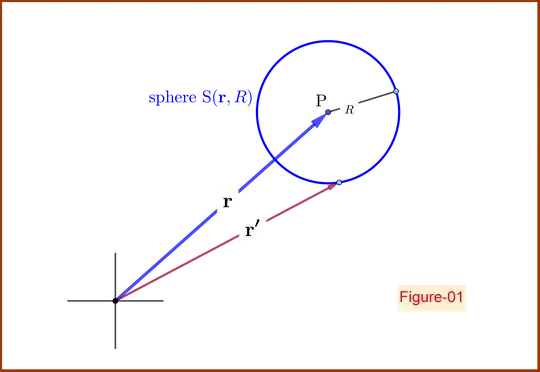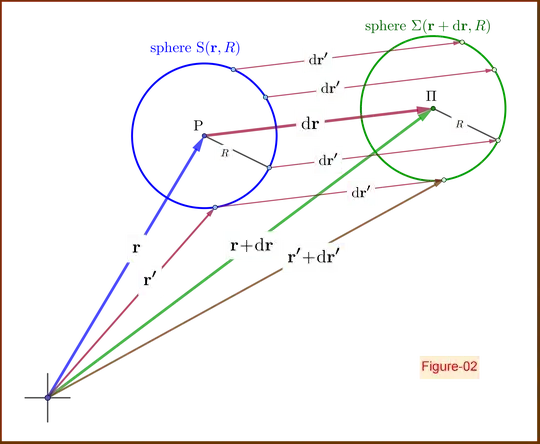
In electrostatics we have
\begin{equation}
\mathbf{E}\left(\mathbf{r}\right)=\boldsymbol{-\nabla_{\mathbf{r}}} V\left(\mathbf{r}\right)
\tag{01}\label{eq01}
\end{equation}
In a region free of charges the electrostatic potential $\;V\left(\mathbf{r}\right)\;$ at a point $\;\mathrm P\;$ with position vector $\;\mathbf{r}\;$ is equal to the average potential on a spherical surface $\,\mathrm S(\mathbf{r},R)\,$with center at $\;\mathrm P\;$ and radius $\;R$, see Figure-01 above
\begin{equation}
V\left(\mathbf{r}\right)=\dfrac{1}{4\pi R^2}\!\!\oint\limits_{\mathrm S(\mathbf{r},R)}\!V\left(\mathbf{r'}\right)\mathrm{dS}=V_{\bf ave}^{\mathrm S}
\tag{02}\label{eq02}
\end{equation}
Note that this value is independent of the radius $\;R\;$ of the sphere as long as it does not contain charges. Inserting expression \eqref{eq02} in equation \eqref{eq01} we have
\begin{equation}
\mathbf{E}\left(\mathbf{r}\right)=\boldsymbol{-\nabla_{\mathbf{r}}}\left[\dfrac{1}{4\pi R^2}\!\!\oint\limits_{\mathrm S(\mathbf{r},R)}\!\!V\left(\mathbf{r'}\right)\mathrm{dS}\right]
\tag{03}\label{eq03}
\end{equation}
Now we must examine if in the rhs of equation \eqref{eq03} it's permissible to insert into the integral the gradient $\;\boldsymbol{\nabla_{\mathbf{r}}}\;$ with respect to $\;\mathbf{r}\;$ as gradient $\;\boldsymbol{\nabla_{\mathbf{r'}}}\;$ with respect to $\;\mathbf{r'}$. In this case
\begin{equation}
\mathbf{E}\left(\mathbf{r}\right)=\dfrac{1}{4\pi R^2}\!\!\oint\limits_{\mathrm S(\mathbf{r},R)}\!\!\bigl[\boldsymbol{-\nabla_{\mathbf{r'}}}V\left(\mathbf{r'}\right)\bigr]\mathrm{dS}=\dfrac{1}{4\pi R^2}\!\!\oint\limits_{\mathrm S(\mathbf{r},R)}\!\!\mathbf{E}\left(\mathbf{r'}\right)\mathrm{dS}=\mathbf{E}_{\bf ave}^{\mathrm S}
\tag{04}\label{eq04}
\end{equation}
That from \eqref{eq03} we could have \eqref{eq04} is proved below.
Proof (see Figure-02 in the bottom)
\begin{equation}
V\left(\mathbf{r}+\mathrm d\mathbf{r} \right)=\dfrac{1}{4\pi R^2}\!\!\oint\limits_{\mathrm \Sigma(\mathbf{r}+\mathrm d\mathbf{r},R)}\!\!\!V\left(\mathbf{r'}+\mathrm d\mathbf{r}\right)\mathrm{d\Sigma}\stackrel{\mathrm d\mathbf{r}\equiv\mathrm d\mathbf{r'}}{=\!=\!=\!=}\dfrac{1}{4\pi R^2}\!\!\oint\limits_{\mathrm \Sigma(\mathbf{r}+\mathrm d\mathbf{r},R)}\!\!\!V\left(\mathbf{r'}+\mathrm d\mathbf{r'}\right)\mathrm{d\Sigma}
\tag{05}\label{eq05}
\end{equation}
\begin{align}
V\left(\mathbf{r}+\mathrm d\mathbf{r} \right)-V\left(\mathbf{r}\right)& =\dfrac{1}{4\pi R^2}\!\!\oint\limits_{\mathrm S(\mathbf{r},R)}\!\bigl[V\left(\mathbf{r'}+\mathrm d\mathbf{r'}\right)-V\left(\mathbf{r'}\right)\bigr]\mathrm{dS}
\nonumber\\
&= \dfrac{1}{4\pi R^2}\!\!\oint\limits_{\mathrm S(\mathbf{r},R)}\!\biggl[\dfrac{V\left(\mathbf{r'}+\mathrm d\mathbf{r'} \right)-V\left(\mathbf{r'}\right)}{\mathrm d\mathbf{r'}}\biggr]\boldsymbol{\cdot}\mathrm d\mathbf{r'}\mathrm{dS}
\nonumber\\
&\stackrel{\mathrm d\mathbf{r'}\equiv\mathrm d\mathbf{r}}{=\!=\!=\!=}\left( \dfrac{1}{4\pi R^2}\!\!\oint\limits_{\mathrm S(\mathbf{r},R)}\!\biggl[\dfrac{V\left(\mathbf{r'}+\mathrm d\mathbf{r'} \right)-V\left(\mathbf{r'}\right)}{\mathrm d\mathbf{r'}}\biggr]\mathrm{dS}\right)\boldsymbol{\cdot}\mathrm d\mathbf{r}
\tag{06}\label{eq06}
\end{align}
\begin{equation}
\dfrac{V\left(\mathbf{r}+\mathrm d\mathbf{r} \right)-V\left(\mathbf{r}\right)}{\mathrm d\mathbf{r}} = \dfrac{1}{4\pi R^2}\!\!\oint\limits_{\mathrm S(\mathbf{r},R)}\!\biggl[\dfrac{V\left(\mathbf{r'}+\mathrm d\mathbf{r'} \right)-V\left(\mathbf{r'}\right)}{\mathrm d\mathbf{r'}}\biggr]\mathrm{dS}
\tag{07}\label{eq07}
\end{equation}
\begin{equation}
\lim_{\mathrm d\mathbf{r}\rightarrow\boldsymbol{0} }\dfrac{V\left(\mathbf{r}+\mathrm d\mathbf{r} \right)-V\left(\mathbf{r}\right)}{\mathrm d\mathbf{r}} = \dfrac{1}{4\pi R^2}\!\!\oint\limits_{\mathrm S(\mathbf{r},R)}\!\biggl[\lim_{\mathrm d\mathbf{r'}\rightarrow\boldsymbol{0}}\dfrac{V\left(\mathbf{r'}+\mathrm d\mathbf{r'} \right)-V\left(\mathbf{r'}\right)}{\mathrm d\mathbf{r'}}\biggr]\mathrm{dS}
\tag{08}\label{eq08}
\end{equation}
\begin{equation}
\dfrac{\mathrm d V\left(\mathbf{r}\right)}{\mathrm d\mathbf{r}} = \dfrac{1}{4\pi R^2}\!\!\oint\limits_{\mathrm S(\mathbf{r},R)}\!\!\!\dfrac{\mathrm d V\left(\mathbf{r'}\right)}{\mathrm d\mathbf{r'}}\mathrm{dS}
\tag{09}\label{eq09}
\end{equation}
\begin{equation}
\boldsymbol{\nabla_{\mathbf{r}}} V\left(\mathbf{r}\right) = \dfrac{1}{4\pi R^2}\!\!\oint\limits_{\mathrm S(\mathbf{r},R)}\!\!\boldsymbol{\nabla_{\mathbf{r'}}}V\left(\mathbf{r'}\right)\mathrm{dS}
\tag{10}\label{eq10}
\end{equation}


